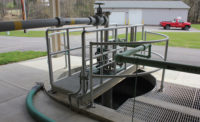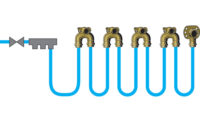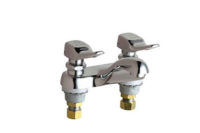|
Water is a resource that has been taken for granted for decades but is now a critical focal point for many companies, communities and governments as the earth faces a water crisis. |
Only 2.5% of the world’s water is fresh water. Of that, only 1% is accessible as much is trapped in glaciers and snowfields. As a result, only a tiny fraction of the planet’s water is available for everyday use. By one estimate, global fresh water demand will exceed supply by a staggering 40% in 2030 if current trends continue.
As corporate citizens, businesses must look at their impact on the environment and assess how their operations affect the communities they operate in and serve. By reducing their source water requirements, food and beverage companies of any size can do their part to reduce environmental impact while reinforcing their corporate social responsibility. Many companies also realize substantial cost savings from water-related investments.
Other benefits of water reuse include:
• Enhancing sustainability practices;
• Ensuring the appropriate water-quality standards for food and beverage processes; and
• Mitigating business risk by lessening dependency on external water sources.
These reasons help explain why water reuse is growing around the world.
Pumping systems
It is important for organizations to consider the transportation and storage of water reuse.
Treatment and pumping systems are primary energy consumers within a water or wastewater loop. Sizing the system and selecting the right equipment to meet specific reuse requirements are critical to maximizing energy savings over the life of the equipment.
Pumps serve two purposes in a reuse system: transporting and pressure-boosting. Water needs to be moved from one location to another for treatment, storage purposes or for use. Pressure-boosting is required for some treatment technologies, including reverse osmosis, where specific pressures are required to move water through a membrane. Many reuse applications, such as irrigation and equipment washing, also require boosting capabilities.
The pump and piping selection can have a considerable impact on the energy consumed over the course of the system’s life. Pumps should be selected to operate at their Best Efficiency Point (BEP) and the plumbing should be engineered to minimize friction loss. Water technology provider Xylem estimates that a water reuse system using improperly sized piping and pumps can increase energy consumption by 200% to 300%.
When implementing a water reuse system:
• Define objectives.When deciding what type of water reuse system is needed in a facility, a plant must define its objectives both from sustainability and cost perspectives.
• Select applications.Next, plant owners and/or operators should define the applications for which the water will be used. It is best to start with high-volume reuse applications that have lower water-quality requirements, therefore requiring less treatment, such as landscape irrigation. By following this approach, the facility will achieve the greatest return on investment as higher levels of treatment drive costs up.
• Determine treatment levels. Finally, determine the treatment levels required for the selected applications by measuring current wastewater quality to establish a baseline. Then compare that to the quality level required for the selected applications. This gap in water quality will determine the treatment intensity.
Pump selection framework
The following five steps can help an industrial plant improve its energy efficiency in water reuse.
1. Determine the flow rate or the volume of fluid that must pass through the pump per unit of time.
2. For a transport application, determine the static head and friction loss for the piping system. Be sure to minimize friction loss when designing the plumbing layout.
Static head is the height of a column of water that would be produced at a given pressure. The calculation represents the internal energy of a fluid due to the pressure exerted on it from the pump.
Friction loss is the loss of energy (reduction of static head) that occurs in the pipe due to viscous effects generated by size and the surface of it. Narrow pipe, corners and valves that impede flow create friction loss.
3. For a boosting application, determine the pressure needed and friction loss for the piping system.
4. Determine the water makeup and comparability. Check the density of the water and check chemical compatibility, such as pH levels.
5. Select the pump by finding the flow curves and BEP. Choose the net positive suction head or the suction head value at a specific flow point required to keep the pump out of cavitation.
When making the final decision, include the following in your list for consideration:
• Certifications (Unlisted Laboratories, CE Marking, NSF-61 for potable water);
• Environmental conditions, which are needed to determine the correct motor enclosure;
• Voltage requirements; and
• Variable-speed options and controllers. Variable-speed control of system pumps has higher installation and equipment costs than constant-speed pumps but can offer significant savings in energy use and operating costs over the life of the system.
Sustainability, health and safety
With increased reports of drought in the news, water reuse is at the forefront of how businesses can expand sustainability efforts and help ensure the available water supply. Beyond water shortage, a greater focus is on social responsibility and water stewardship. In part, due to public indices such as the Dow Jones Sustainability Index, companies are investing more heavily in their sustainability efforts and are better managing their water use.
Another driver of water reuse is health and safety mandates. Food and beverage operations must comply with the U.S. Food and Drug Administration as well as the U.S. Environmental Protection Agency and other relevant regulatory bodies. The standards put in place by these organizations to regulate wastewater quality vary but apply in some form to all plants, regardless of size. For example, in 2012, the EPA released a document outlining state and federal water reuse guidelines for all industries.
Any company operating in a foreign country also should be aware of international regulatory bodies and standards. Reuse mandates vary from country to country but many businesses are looking to the United States and Europe as examples of countries implementing regulations that could affect them.
With LEED certification incentives and stricter regulations on water use in many communities, particularly those in drought-stricken regions of the country, water reuse will be an increasingly growing practice.
Plumbing and mechanical engineers involved in installing water recycling systems must be up to date on plumbing codes and other regulations to ensure systems are in compliance, as no consistent standards — nationally or otherwise — exist in this emerging field.
HELPFUL LINKS:



